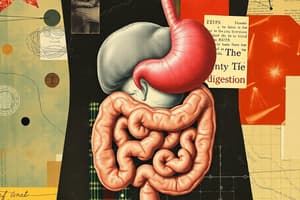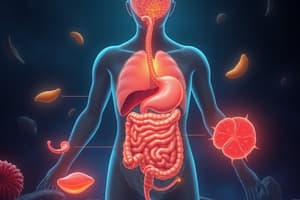Podcast
Questions and Answers
What does absorption refer to in the digestive process?
What does absorption refer to in the digestive process?
- The breakdown of food into simpler molecules
- The movement of molecules into the blood and lymphatic vessels (correct)
- The elimination of waste from the body
- The secretion of digestive enzymes
Which of the following describes hyperglycemia?
Which of the following describes hyperglycemia?
- A condition of low blood sugar levels
- Presence of glucose in the urine
- An increase in blood sugar concentration (correct)
- A tumor resulting in high insulin production
What is the primary role of carbohydrates in human nutrition?
What is the primary role of carbohydrates in human nutrition?
- To transport oxygen in the bloodstream
- To aid in the digestion of proteins
- To serve as the main source of energy (correct)
- To provide structural support in cells
Which monosaccharide is known as a hexose?
Which monosaccharide is known as a hexose?
What occurs during defecation?
What occurs during defecation?
In which condition is there a decreased secretion of insulin?
In which condition is there a decreased secretion of insulin?
Which of the following carbohydrates is primarily found in plant cells?
Which of the following carbohydrates is primarily found in plant cells?
Which condition results from the presence of glucose in the urine?
Which condition results from the presence of glucose in the urine?
Which organs are primarily responsible for carbohydrate storage in the body?
Which organs are primarily responsible for carbohydrate storage in the body?
How long can the body's stored carbohydrate typically meet energy needs?
How long can the body's stored carbohydrate typically meet energy needs?
Which of the following tissues is the most important consumer of glucose?
Which of the following tissues is the most important consumer of glucose?
What is gluconeogenesis?
What is gluconeogenesis?
What hormone is essential for facilitating glucose transfer into cells?
What hormone is essential for facilitating glucose transfer into cells?
Which cells depend almost entirely on glucose for energy under fasting conditions?
Which cells depend almost entirely on glucose for energy under fasting conditions?
What metabolic process helps maintain blood glucose levels during fasting?
What metabolic process helps maintain blood glucose levels during fasting?
Which of the following is NOT a source of gluconeogenesis?
Which of the following is NOT a source of gluconeogenesis?
What is the storage form of carbohydrates in plants?
What is the storage form of carbohydrates in plants?
Which polysaccharide acts as an anticoagulant and is stored in mast cells?
Which polysaccharide acts as an anticoagulant and is stored in mast cells?
Which of the following is a characteristic of glycogen?
Which of the following is a characteristic of glycogen?
What role does cellulose play in the diet?
What role does cellulose play in the diet?
Which property makes inulin a good index for assessing glomerular filtration rate (GFR)?
Which property makes inulin a good index for assessing glomerular filtration rate (GFR)?
What is the normal concentration of glucose in the blood?
What is the normal concentration of glucose in the blood?
Which of the following sugars is the sweetest and most soluble?
Which of the following sugars is the sweetest and most soluble?
What is galactose primarily derived from?
What is galactose primarily derived from?
Which condition is associated with the inability to metabolize fructose?
Which condition is associated with the inability to metabolize fructose?
Which disaccharide is composed of glucose and galactose?
Which disaccharide is composed of glucose and galactose?
What is the primary composition of maltose?
What is the primary composition of maltose?
Polysaccharides are primarily characterized by being:
Polysaccharides are primarily characterized by being:
What condition is associated with glucose excretion in urine?
What condition is associated with glucose excretion in urine?
What is the normal fasting blood sugar (FBS) level considered to be?
What is the normal fasting blood sugar (FBS) level considered to be?
What condition is assessed using Random Blood Sugar (RBS) testing?
What condition is assessed using Random Blood Sugar (RBS) testing?
What does a Hemoglobin A1c (HbA1c) level of 6.5% or higher indicate?
What does a Hemoglobin A1c (HbA1c) level of 6.5% or higher indicate?
What parameter is used to diagnose gestational diabetes during pregnancy?
What parameter is used to diagnose gestational diabetes during pregnancy?
What is the significance of a blood sugar level of ≤ 60 mg/dl?
What is the significance of a blood sugar level of ≤ 60 mg/dl?
What are symptoms of hypoglycemia that may appear around 50-55 mg/dl?
What are symptoms of hypoglycemia that may appear around 50-55 mg/dl?
Which type of carbohydrate cannot be hydrolyzed into simpler sugars?
Which type of carbohydrate cannot be hydrolyzed into simpler sugars?
Which of the following is the normal value range for a 2-hour postprandial blood sugar test (2-HPPBS)?
Which of the following is the normal value range for a 2-hour postprandial blood sugar test (2-HPPBS)?
Flashcards are hidden until you start studying
Study Notes
Digestive Processes
- Absorption: Movement of molecules via passive diffusion or active transport from the digestive tract to blood and lymphatic vessels; crucial for entering digested food into the body.
- Defecation: Elimination of undigested materials through the anus.
Carbohydrates Overview
- Composed of hydrogen, carbon, and oxygen.
- Major dietary component and important energy source for the body.
- Stored primarily as glycogen in muscles (0.5% of wet weight) and the liver (up to 10% of wet weight).
- Total glycogen storage supports energy needs for about half a day.
Key Terms
- Hyperglycemia: Elevated glucose levels in the blood.
- Hypoglycemia: Reduced glucose levels in the blood.
- Glycosuria: Presence of glucose in urine.
- Hyperinsulinism: Increased secretion of insulin.
- Hypoinsulinism: Decreased secretion of insulin.
- Insulinoma: Tumor in the pancreas causing increased insulin production.
Carbohydrate Classification
- Based on the number of carbon atoms: triose (3), tetrose (4), pentose (5), hexose (6).
- Monosaccharides (simple sugars) include glucose, fructose, and galactose; significant in nutrition.
- Dietary carbohydrates exist mainly as sugars and starches.
Glucose Utilization
- Glucose is the principal carbohydrate in blood and a primary energy source for glucose-dependent cells like the brain, red blood cells, and others.
- Under fasting conditions, gluconeogenesis occurs, using proteins from muscles to generate glucose.
- Liver gluconeogenesis is crucial for maintaining blood glucose levels during fasting.
Diabetes Mellitus
- Associated with inadequate insulin levels, affecting glucose transport into cells.
- Brain is particularly vulnerable to low blood sugar levels.
Laboratory Tests for Carbohydrate Metabolism
- FBS (Fasting Blood Sugar): Required fasting for 6-8 hours; normal value < 100 mg/dl.
- RBS (Random Blood Sugar): Collected anytime; normal value < 140 mg/dl.
- 2-HPPBS (2-hour Post Prandial Blood Sugar): Monitors insulin response; normal value < 140 mg/dl.
- HbA1c: Indicates average glucose levels over 2-4 months; normal < 5.7%.
- OGTT/IVGTT: Tests for gestational diabetes.
Normal Value Ranges for Blood Sugar
- Hyperglycemic hormone release at 65-70 mg/dl.
- Hypoglycemia suggested at ≤ 60 mg/dl.
- Symptoms of hypoglycemia may appear at around 50-55 mg/dl.
Functions of Carbohydrates
- Serve as major energy sources.
- Structural components in biological systems.
- Function as energy reserves, sparing proteins during metabolism.
Polysaccharides Classification
- Starch: Storage form in plants, consisting of amylose (linear) and amylopectin (branched).
- Glycogen: Storage form in animals, highly branched structure.
- Cellulose: Indigestible polysaccharide aiding bowel movement.
Examples of Sugars
- Glucose: Blood sugar with a normal concentration < 100 mg/dl; excess is converted to glycogen or fat.
- Fructose: Found in honey, sweetest of sugars; related condition: fructosemia.
- Galactose: Present in glycoproteins; related condition: galactosemia.
Disaccharides
- Lactose: Composed of glucose and galactose; found in milk.
- Maltose: Contains two glucose units; forms during starch digestion.
- Sucrose: Composed of glucose and fructose; known as table sugar.
Understanding carbohydrates helps in grasping their role in nutrition, energy regulation, and their impact on health conditions like diabetes.
Studying That Suits You
Use AI to generate personalized quizzes and flashcards to suit your learning preferences.




